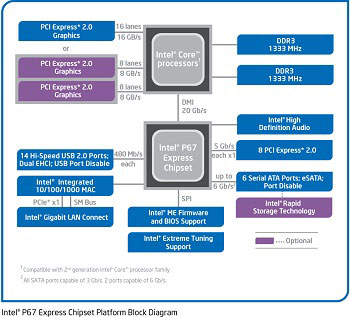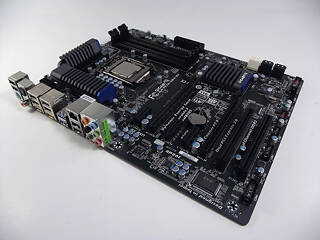 16
16
Gigabyte GA-P67A-UD4-B3 Review
Packaging & Contents »Intel P67 Chipset
A few short months ago, Intel launched their latest platform, codenamed SandyBridge. Shortly after release the majority of motherboard chipsets were recalled by Intel for a revision, and today, all of those products are back on the store shelf, and not without a bit of fanfare. Manufacturer packaging lauds the inclusion of the latest revision of Intel's P67 chipset, the B3 stepping, and with good reason, as this indicates that the chipset's SATA 6 Gbps drive controller will survive throughout the warranty period.

The above block diagram shows basic layout and functionality of Intel's P67 chipset. Supporting four SATA2 channels and two SATA 6 Gbps channels natively, it offers full functionality and speed for both internal drives as well as for external drives over eSATA and USB3.0, thanks to a full-speed PCIe 2.0 implementation integrated directly into the CPU and chipset. In fact, the P67 chipset merely serves as a basic input/output hub, with the majority of features previously relegated to the chipset now fully integrated within the CPU silicon itself. This serves to provide high-speed, low latency throughput, but at the same time, does limit expansion possibilities a bit. With 16 PCIe 2.0 lanes in the CPU itself, and another eight lanes in the P67 silicon, the platform supports dual graphics connected directly to the CPU itself, and the remaining add-in devices, unless situated in one of the graphics ports, are all managed by the P67 chipset proper.
Like the past P55 chipset, USB3.0 connectively is not provided natively, although unlike P55, the fullspeed PCIe 2.0 implementation in the P67 chipset ensures that external SATA2/3 and USB3.0 controllers receive the bandwidth they need. USB 2.0, on the other hand, is almost over-allocated, with a total of 14 ports driven natively off the P67 chipset. Lost, though, is legacy device support for things like IDE drives and Floppy controllers, although like USB3.0, these can be added by board manufacturers if they really want to. With drive technology advances where they are today, we've tossed out such legacy devices for recycling in favor of today's excellent drive performance and hope that almost everyone else does too.
All of those features are wrapped up together in a stealthy and sleek matte black finish, forming the base of the board we've been testing recently, the Gigabyte P67A-UD4.
Apr 18th, 2025 03:59 EDT
change timezone
Latest GPU Drivers
New Forum Posts
- It's happening again, melting 12v high pwr connectors (1025)
- Will you buy a RTX 5090? (480)
- Subsystem Id of my Asus Strix RTX 4090 OC / Random GPU detection problem (7)
- RX 9000 series GPU Owners Club (373)
- D5400XS Skulltrail (1)
- Help For XFX RX 590 GME Chinese - Vbios (8)
- Random Entire System Stutter when using Throttlestop (7)
- Help needed OC on Intel 285k (3)
- 3090 zotac Trinity Oc dead or psu weak? (39)
- RTX5000 Series Owners Club (181)
Popular Reviews
- ASUS GeForce RTX 5060 Ti TUF OC 16 GB Review
- NVIDIA GeForce RTX 5060 Ti PCI-Express x8 Scaling
- G.SKILL Trident Z5 NEO RGB DDR5-6000 32 GB CL26 Review - AMD EXPO
- Palit GeForce RTX 5060 Ti Infinity 3 16 GB Review
- ASUS GeForce RTX 5060 Ti Prime OC 16 GB Review
- Zotac GeForce RTX 5060 Ti AMP 16 GB Review
- MSI GeForce RTX 5060 Ti Gaming OC 16 GB Review
- MSI GeForce RTX 5060 Ti Gaming Trio OC 16 GB Review
- ASUS GeForce RTX 5080 TUF OC Review
- Teevolution Terra Pro Review
Controversial News Posts
- NVIDIA GeForce RTX 5060 Ti 16 GB SKU Likely Launching at $499, According to Supply Chain Leak (182)
- NVIDIA Sends MSRP Numbers to Partners: GeForce RTX 5060 Ti 8 GB at $379, RTX 5060 Ti 16 GB at $429 (127)
- Nintendo Confirms That Switch 2 Joy-Cons Will Not Utilize Hall Effect Stick Technology (105)
- Over 200,000 Sold Radeon RX 9070 and RX 9070 XT GPUs? AMD Says No Number was Given (100)
- Nintendo Switch 2 Launches June 5 at $449.99 with New Hardware and Games (99)
- NVIDIA Launches GeForce RTX 5060 Series, Beginning with RTX 5060 Ti This Week (96)
- Sony Increases the PS5 Pricing in EMEA and ANZ by Around 25 Percent (85)
- NVIDIA PhysX and Flow Made Fully Open-Source (77)

